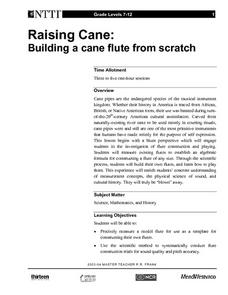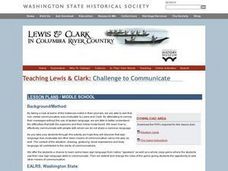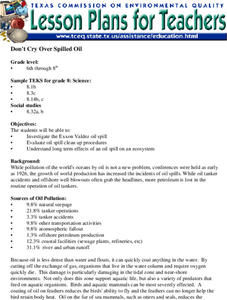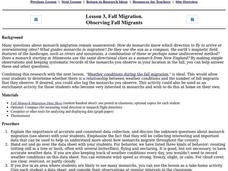Curated OER
Foil Action Figures
Learners create a foil sculpture representative of a human figure and a landscape drawing as a backdrop for their figure.
Curated OER
"You Shall Do Your Best Endeavor" - Working With Primary Documents
Students read and interpret primary source documents regarding historic Jamestown. In small groups, they read the primary documents, answer questions, and view online maps of Jamestown Island and Virginia.
Curated OER
"What Do You Mean?" How Language Changes Over Time
Learners examine words used at Jamestown in 1607. They predict what the words meant in 1607, write sentences using three of them, then analyze the sentences after they have read the actual definitions of the words.
Curated OER
Raising Cane: Building a Cane Flute From Scratch
Eighth graders create their own cane flute. They use a model flute to gain the correct measurements and use the scientific method to construct the flute to have sound quality and pitch accuracy.
Curated OER
North Carolina Place Names
Fourth graders examine a map of North Carolina to discover the heritage left behind in the names of various places. They compare/contrast those derived from Native American culture to those derived from European settlers.
Curated OER
Teaching Lewis and Clark: Challenge to Communicate
Young scholars note instances in the journals of Lewis and Clark where they relied on non-verbal communication (sign language.) They discover some basic sign language and play a game in which they must use their new sign language skills...
Curated OER
Don't Cry Over Spilled Oil
Learners study the Exxon Valdez Oil Spill while evaluating oil spill clean up activities. They discover the long term impact can have on an ecosystem by completing this experiment.
Curated OER
Lesson One: Mark Twain and Will Rogers - American Originals
Students research the lives of Mark Twain and Will Rogers. They watch videos and research websites to find information and compile examples of each man's writings which they present to the class.
Curated OER
Using SWMP Data
Students are introduced to the SWMP system which tracks short-and long-term changes in water. Using this data, they plot and interpret the data on a graph to determine how human activities are lowering the water quality. They also...
Curated OER
Stratigraphy -- Layers of Time in the Earth
Students are introduced to the process of stratification. Using the internet, they read about the Richard Beene archeological site near San Antonio. Using a map, they color code the different layers present at this site and answer...
Curated OER
China
Students explore the geography, culture and history of China. As a class, they discuss historical contributions to China, Confucius, and geographic features of the country. Pupils use the internet to answer questions about China.
Curated OER
NCTA Lesson Plan on Japan
Students investigate a controversial issue of discrimination based upon a caste system in Japan. It is compared to India and they use research methods to make discoveries concerning the history and similarities to the two systems.
Curated OER
Observing Fall Migrants
Students keep a detailed data collection log of the different types of monarch behavior. They track the weather conditions daily and link it to the migration of the monarchs. They summarize their data using either a graph or a computer...
Curated OER
Snow vs. Water
Young scholars fill three cups with snow. They record the height of snow in each cup, and allow the snow to melt. Students measure the height of the water in each glass or cup, and record their results on the worksheet. They answer...
Curated OER
Tracking the Storm
Young scholars discuss the different types of storms that can hit land. They locate specific coordinates on a plane grid. They discuss lonsgitude and latitude to plot the coordinates of a tropical storm. They practice finding...
Curated OER
Homes Sweet Homes
Young scholars view various examples of homes by Robert Harris. In groups, they describe how houses are different in various climates around the world. Individually, they use one artifact from their own home and research its...

















